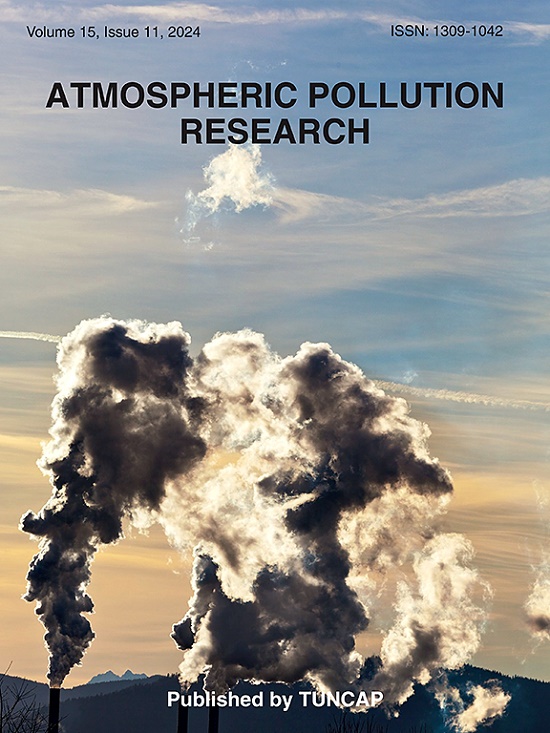Inverse modeling of 137Cs during Chernobyl 2020 wildfires without the first guess
IF 3.9
3区 环境科学与生态学
Q2 ENVIRONMENTAL SCIENCES
引用次数: 0
Abstract
This study estimates 137Cs emissions from Chernobyl wildfires in April 2020 using inverse modeling. Emissions are resolved with daily resolution by particle sizes (0.4 m, 8 m, 16 m) and altitudes (up to 3 km). The inverse problem’s complexity requires regularization due to its ill-posed nature. One potential way to regularize the problem is the use of the so-called first guess, i.e. emission taken from expert knowledge or previous literature. However, inappropriately chosen first guess may lead to serious bias in results or its availability may be limited for rapid response. We rather follow a Bayesian approach where all model parameters are considered as variables to be estimated from available data. We aim to combine three key principles: modeling of sparsity and smoothness of the emission vector, modeling of bounded ratios between released particle size/altitude fractions, and bias correction of the atmospheric transport model. All these principles proved their significance separately, however, we combine them in one comprehensive method to estimate the 137Cs emissions from the Chernobyl wildfires. The total released activity was estimated to be 458 GBq with uncertainty estimated to be 69 GBq. Our estimates also suggest that most of the activity has been released below a one-kilometer altitude with the more dominant role towards the smallest particle fraction than was considered in other studies. Using our estimate, we calculate the time-integrated volumetric activities of 137Cs over the domain using the JRODOS system and our findings well agrees with previous results.
在没有第一次猜测的情况下,对切尔诺贝利2020年野火期间的137Cs进行逆建模
这项研究使用逆模型估计了2020年4月切尔诺贝利野火的137Cs排放量。根据颗粒大小(0.4 μm, 8 μm, 16 μm)和海拔高度(高达3公里),以日分辨率对排放进行分辨。由于逆问题的病态性质,它的复杂性需要正则化。一种使问题规范化的潜在方法是使用所谓的第一次猜测,即从专家知识或以前的文献中获得的发射。然而,选择不当的第一猜测可能会导致结果的严重偏差,或者可能会限制其快速反应的可用性。我们更愿意遵循贝叶斯方法,其中所有模型参数都被视为从可用数据估计的变量。我们的目标是将三个关键原则结合起来:发射矢量的稀疏性和平滑性建模,释放的粒径/高度分数之间的有界比建模,以及大气输送模型的偏差校正。所有这些原则分别证明了它们的重要性,然而,我们将它们结合在一个综合方法中来估计切尔诺贝利野火的137Cs排放量。总释放活度估计为458 GBq,不确定性估计为69 GBq。我们的估计还表明,大多数活动是在一公里以下的高度释放的,其中最小颗粒的作用比其他研究认为的更大。利用我们的估计,我们使用JRODOS系统计算了该区域上137Cs的时间积分体积活动,我们的发现与之前的结果很好地一致。
本文章由计算机程序翻译,如有差异,请以英文原文为准。
求助全文
约1分钟内获得全文
求助全文
来源期刊

Atmospheric Pollution Research
ENVIRONMENTAL SCIENCES-
CiteScore
8.30
自引率
6.70%
发文量
256
审稿时长
36 days
期刊介绍:
Atmospheric Pollution Research (APR) is an international journal designed for the publication of articles on air pollution. Papers should present novel experimental results, theory and modeling of air pollution on local, regional, or global scales. Areas covered are research on inorganic, organic, and persistent organic air pollutants, air quality monitoring, air quality management, atmospheric dispersion and transport, air-surface (soil, water, and vegetation) exchange of pollutants, dry and wet deposition, indoor air quality, exposure assessment, health effects, satellite measurements, natural emissions, atmospheric chemistry, greenhouse gases, and effects on climate change.
 求助内容:
求助内容: 应助结果提醒方式:
应助结果提醒方式:


